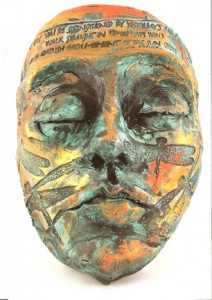I was recently contacted by Art in the School, a 501(c)(3) non-profit program in New Mexico. They requested an approval to use this image, Prayer, in their program for teaching art.
Well, of course! I was delighted – only I couldn’t find the image in my files (ahem – artists, this points up to being organized!). I did have it in my VistaPrint portfolio, so we worked out that I would order 50 large postcards with the image on it for their program. The image here is scanned from an older postcard/previous mailing.
And, as I am always intrigued when my art piques interest, I invited Beth Larsen, Executive Director of the Program, to interview and tell us a bit more about the program. Know you will enjoy it!
Tell us about your program Art in the School
Art in the school was founded in 1985 by art historian, Sara Otto Diniz, who was dismayed to discover that art had been totally eliminated from the public schools. We have two programs:
1) Art in the School’s volunteer program trains parents to teach four comprehensive art lessons in their children’s classrooms. We prepare parents for this by inviting a local expert, such as an art historian or artist, to talk about the lesson’s topic. Then an art teacher shows how to look at and discuss art images with children and teach them art making.
2) In 2007, we began our After School Art Program at local Title 1 elementary schools. We consulted with the University of New Mexico’s Art Education Program faculty when designing the program. We hire UNM Art Education graduate students and other arists to teach the children, which gives the children and the teachers great experience. This year, we are expanding the After School Program to a middle school.
All of this is provided through grants and donations, at no cost to the schools. The program serves more than 6,500 children this year!
How do you decide what art to use with the children?
For our Volunteer Program, we have 30 lesson guides which provide the framework for everything from Paleolithic cave painting to the art of New Mexico to modern architecture. Our founder, who retired after heading the organization for 20 years, wrote the lessons. Each lesson has specific images associated with it: some of well known masterpieces and some with lesser known images.
Our After School Programs each have a specific curriculum. The elementary program has 10 lessons covering a wide range of mediums, including drawing, watercolor, gyotaku (fish prints), Hispanic tin work, weaving, clay, mask making and more. The new Middle School program begins with a solid foundation in drawing technique, focusing on self portraits. Then it explores self-image in clay, collage, painting and wire sculpture. Bethe Sailer [who contacted me], a wonderful local artist and art teacher, wrote the after school curriculum. Our art teachers show posters of the images before each lesson to help put the art into cultural context for the children. The Middle School After School Program will also bring in several local artists to share their artwork and demonstrate their art-making techniques. The semester will end with a trip to the Albuquerque Art Museum. Looking at and discussing works of art are an important part of what we do.
What have some of your most successful projects been and how do you determine “success” when working on a project with children?
Last year we did a lesson on quilt making. One volunteer shared stories of how 5th grade boys got so enthusiastic about learning how to sew and make their small quilt! In the after school program, one of the children’s favorite lessons is on making a Mayan hand puppet. I receive many evaluation forms back from kids saying that it was their favorite project.
How to determine successful art making/learning: that is a big question! As executive director, I send evaluation forms to parents and to the children, too. Their comments are always extremely positive. But I think that children gain so much from art that can’t be measured, and that they can’t articulate. We can see the joy in their faces and watch as they enthusiastically are engaged. Since Art in the School has been around for 24 years, we are now getting parent volunteers joining us who had Art in the School when they were kids. They share their fond memories of the lessons and their desire to instill a love of art in their children.
What do you hope the children take away from their work with art?
Art education is a fundamental part of quality education. Children today are exposed to a barrage of visual images all day long – more so than ever before. Art education can help them interpret images and put art in its cultural context. Our goal isn’t to necessarily encourage children to become artists (that’s ok, but not the basic goal). I think that looking at and making art teaches thinking and problem solving skills that are beneficial no matter what path one pursues in life. I recently read a great book that is the best description of this that I have seen: Studio Thinking: The Real Benefits of Visual Arts Education by Lois Hetland, Ellen Winner, Shirley Veenema and Kimberly M. Sheridan. They describe the benefits as learning to develop craft, to engage and persist, envision, observe, reflect, think metacognitively, to stretch and to explore. These are 21st century skills our kids need.
What mediums do you use?
Everything from pencil/charcoal drawing, to watercolor and tempera painting, to clay, collage, tin work, print making – a little of everything!
What drew you to “Prayer?”
Bethe Sailer wrote the curriculum and she chose Prayer because it provides a great example of contemporary clay mask-making. It demonstrates the concepts of proportion, form, texture and color so well. Plus, it’s just a very beautiful and interesting piece to look at.
What are your favorite art books for children?
I love Mike Veneziaa’s series of 47 books: Getting to Know the Word’s Greatest Artists [i.e. Georgia O’Keeffe (Getting to Know the World’s Greatest Artists) et al]. They’re an easy read for kids age 9 – 12 and fun, but full of great information, too. Nina Laden has some great ones: When Pigasso Met Mootisse
(age 4 – 10) pokes fun at Picasso and Matisse and is very funny. Roberto, The Insect Architect
(age 6 – 11) is another of hers, and has a wonderful message about being different from others and holding fast to your dreams.
What is the one thing we can do for our kids to encourage and support their creativity?
Insist on art education in every school for every child! The lack of quality art education provided by certified art teachers is a serious deficit in our school systems nationwide. But until that happens, make art part of your family’s culture. Turn off the TV, give your kids some crayons, paper, scissors, simple art supplies, empy boxes, string, yarn, etc. – it doesn’t have to be expensive stuff – and encourage them to create. Take them to art and other museums, art fairs, and appreciate the art in your community. It’s surprising what they absorb. My advice is to keep it light and fun and always joyful.
Do you have a website with pictures done by the children that you can share?
Yes! Our blog has photos and changes frequently. [ you can also find Art in the School on Facebook here]
Can folks donate to your program?
Absolutely! We’re a very small organization, so each and every donation is very important to us and greatly appreciated. The easiest way is via our website via PayPal. A check by snail mail also works great! Make the check to Art in the School and mail to us at PO Box 3416, Albuquerque, NM 87190-3416.
Wylde Women’s Wisdom: Ordinary education and social training seem to impoverish the capacity for free initiative and artistic imagination. We talk independence, but we enact conformity….There must be more to life than all these learned acts, all this highly conditioned consumption. A person wants to do something of her own. to feel her own being alive and unique. She wants out of bondage. She wants into the promised land. M.C. Richards



